Swansea Fforestfach factory |
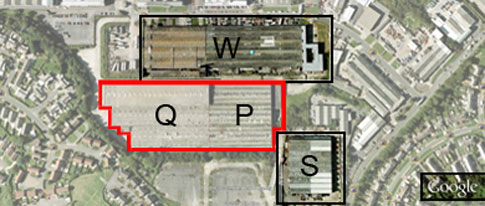
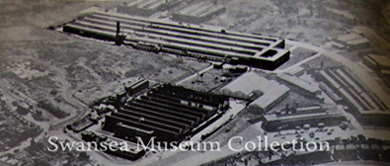 |
The Early Years (1932-1945)
The Mettoy Co. Ltd. was registered as a private company on 31 August, 1932.
It was founded by Philipp Ullmann and Arthur Katz, both of whom had previously
worked in toy manufacturing. Ullmann had originally set up in business as
Tipp & Co. in Nurenberg, Germany as a manufacturer of mechanical pressed
tin toys. Katz, whose mother was Ullmann's cousin and who was born in Johannesburg
in March 1908, moved to Nuremberg from South Africa in 1920 and joined Tipp
& Co. on leaving school. Following Hitler's rise to power in 1933, Ullmann,
and then Katz, who were both Jewish, moved to Britain, the former with the
assistance of Lord Marks, of Marks and Spencers fame.
This relationship was to continue, with Marks and Spencers becoming a major
buyer of Mettoy's products after the war. Ullmann was formally appointed to
the Board of Directors of Mettoy on 10 October 1933, and space was found for
him and Katz in a workshop in St Andrews Street, Northampton, owned by Winteringham
Ltd., a model engineers and off-shoot of Bassett-Lowke. Using lithographed
sheets of tin, Ullmann and Katz started to produce toys, many of them fitted
with clockwork mechanisms, and commenced trading as the Mettoy Company Ltd.
on 1 February 1934.
The company slowly expanded, and in February 1936, with a workforce of approximately 50 people, broke away from Winteringham Ltd., moving into larger premises in Stimpson Avenue, Northampton. Arthur Katz was appointed to the Board of Directors on 27 May 1936. The business continued to grow forcing a further move to larger premises in Harleston Road, St James End, Northampton in 1937.
With the outbreak of war in 1939, production was gradually turned over to
munitions, and toy production ceased entirely in 1941. Instead, Mettoy manufactured
a wide range of munitions and military equipment, including heavy steel Jerry
can components and shell fuses, shell and mortar carriers, Sten and Bren Gun
magazines and landmines in their Northampton factory, and
also in a new facility, erected by the Ministry of Supply in 1944 and measuring
28,000 sq. ft., at Fforestfach on the outskirts of Swansea, South Wales.
During the war the company gained a reputation for the speed and success with
which it solved precision engineering problems.
________________________________________
Post-War Growth (1945-54)
After the war Mettoy quickly returned to toy manufacturing, and by 1948
had started building a new, 115,00 sq. ft. factory at Fforestfach.
This was constructed to include a number of modern features, including internal
conveyor belts which allowed products to move through the factory in a straight,
and more efficient, line. Worker comfort was also important in the design,
which featured a large number of windows to let in natural light and plant
machinery painted in light colours for a restful effect on the operators.
The decision to base production in Swansea had been made due to the fact that
there was a ready source of raw materials, and also that the area suffered
from an inadequate range of employment opportunities in relation to the size
of the local work force. The factory was officially
opened on 2 April 1949, and was further extended
to 200,000 sq. ft. at the beginning of 1952 when it became the Company’s
headquarters, accommodating all of Mettoy’s production and commercial
sections.[1] The Northampton premises were retained for the tool-making, sample-making,
design and development departments. The company also had London showrooms
at Finsbury Pavement House, 120 Moorgate, EC2. By now, Katz was its Managing
Director and Ullmann its Chairman.
The increase in the size of the factory allowed for the installation of high-capacity
injection-moulding machinery, which in turn enabled the company to move away
from the manufacture of tin-plate toys to those produced from plastic, in
the process establishing strong export markets. It also began to design, develop
and manufacture its own production machinery. It is also at this time that
Mettoy manufactured their first ‘Heavy Cast Mechanical Scale Models’
for Marks and Spencers, designed and cast at the Birmingham Aluminium Casting
Co., Smethwick, in 1948. This change in direction was driven to some extent
by Henry Ullmann, Philipp’s son, who was appointed to the Board of Directors
in April 1947. Further expertise in die-casting came to the company in November
1953, when Howard Fairbairn, previously head of development at the Birmingham
Aluminium Casting Co., joined the Board of Directors. At the time die-casting,
although a well-established process, was relatively exclusive to a small section
of the toy industry. As such, Mettoy relied upon its own resources and engineering
skills to set up its pressure die-casting departments, and for the production
of the necessary, highly-specialised plant.
On 12 1953, Playcraft Toys Ltd. was registered as a toy-trading company, and
the following May became a wholly-owned subsidiary of Mettoy Co. Ltd., with
the majority of Mettoy’s home sales to retail being conducted through
Playcraft. Like their parent company, Playcraft also had offices in Finsbury
Pavement House, London.
Corgi and other Successes (1955-1969)
The late 1950s to mid 1960's saw an increase in the number of products offered
by Mettoy. New ranges included the 'Wembley' vinyl sports- and playballs,
'Sunshine' vinyl figures and Aurora plastic model kits,[2] all of which were
first produced in 1958. The ranges advertised in the early 1960's also included
Playcraft Railways (both electric and clockwork model railways in OO/OH scale
launched in March 1961), Vapour Trails (model aircraft), Child Guidance Toys
(a range of educational toys for the younger child, first produced in 1960,
and made from washable and unbreakable polythene), and Electric Highways (an
OO gauge electric roadway system and the forerunner of the 'Champion' electric-powered
racing system which first appeared in 1964). Mettoy also expanded into wooden
toys, with the Playcraft Wooden Toys range, and for the first time soft toys,
with the Berg range of plush animals, both introduced in 1965. As a result
of the success of the Playcraft sales force, Mettoy also took over the marketing,
on an exclusive basis, of a number of products manufactured by other companies,
including the 'Bandbox' radio and the Petite Typewriter.
The cornerstone of Mettoy's success and expansion in this period, however,
was the Corgi range. This was first envisaged in 1955, when the first drawings
for the new range were produced, and launched by Playcraft Toys Ltd. in 1956.
The first six vehicles were saloon cars, but the range was to expand quickly
over the next year. In December 1956, the Corgi Model Club, with its regular
newsletter, launched, and the first Corgi catalogue was produced shortly afterwards
in 1957 and included a number of larger vehicles, such as Bedford Tractors
and Mobilgas Petrol Tankers. It was soon decided that there would be a new
Corgi model release to the trade every month, and in 1964 the Corgi Classics
and 'Husky' ranges were also introduced. The former, featuring models of veteran
and vintage cars, was launched to celebrate Mettoy's 30th Anniversary, while
the latter was produced exclusively for Woolworths.[3]
The success of Mettoy at this time is illustrated by its sales figures. By
the late 1950's, Mettoy was exporting to over 100 countries, accounting for
nearly 33% of the Company's turnover. In 1959 alone, the company saw its export
business increase by 41%, which included a 33% rise in exports to the United
States, as well as breaking into the Far East market for the first time. This
did not prevent Arthur Katz from undertaking a two-month world tour to New
Zealand, Hong Kong and Australia in 1961 to further boost export sales. The
level of the Company's success was further demonstrated on 5 June 1963, when
Mettoy Co. Ltd. was floated on the London Stock Exchange. This drew in £43
million, and was over-subscribed 91 times over. At the end of 1963, the workforce
stood at 1700.
The success of Mettoy can also be measured in the number of awards it received
in this period, including an OBE for Arthur Katz in November 1961 for services
to the toy industry. In 1964, the Petite Typewriter won a gold medal at the
International Inventors Exhibition in Brussels. In April 1966, Mettoy won
the Queens Award to Industry, a success it was to twice repeat, in 1967 and
1969. Also in April 1966 it won the inaugural National Association of Toy
Retailers' 'Toy of the Year' award, and also 'Best Toy of the Year for Boys'
award for its James Bond Aston Martin DB5 Corgi model. It also received its
first 'Range with the Highest Standard' award, again from the NATR, and continued
to win it for the next three years running. Katz received a second honour,
this time a CBE, in 1973.
Expansion of the Company's infrastructure also occurred in the mid- to late-1960's,
with Mettoy acquiring 75% of the capital of N&R Green, manufacturers of
Warwick roller skates, in 1964, including their factory in Solihull, Warwickshire.
Mettoy Playcraft (Sales) Ltd. was formed in early 1966, to take over and rationalise
all the marketing functions of Mettoy and Playcraft, which had previously
been split between the two companies.[4] This new company began by initiating
Corgi's first advertising programme in the United States, in conjunction with
Reeves International, the range's American importer.
By 1968, the combined floor space of Mettoy's factories and warehouses was
approximately 385,000 sq. ft., with additional showrooms in Swansea, Northampton,
Glasgow and Toronto as well as the one in London. It had a workforce numbering
some 3500.
______
__________________________________
Early
Losses (the 1970's)
In 1971 Mettoy reported its first ever trading loss, of £441,000 before
tax. Reasons given for this at the time included the saturation of the North
American market, stiffer competition, notable increases in the cost of principal
raw materials, and also a reduction in the upper-age limit of children buying
Corgi models. As a result, the Stanley Road factory in Northampton closed
in August, with a loss of nearly 900 jobs. The company also lost its founder,
with the death of Philipp Ullmann, aged 88, on the 20th September 1971. He
had retired as Chairman and Director of Mettoy two years previously (succeeded
as Chairman by H.J. Isner), but had continued in the role of President.[5]
Despite this poor start, the remainder of the decade saw further expansion
and financial success, with turnover leaping from £9.3 million to £19.9
million between 1972 and 1976, and with 1978 heralded by Peter Katz, the then
Managing Director of Mettoy, as the Company's best ever year. In 1973 it acquired
48,000 sq. ft of additional space at Skewen, near Neath, South Wales, for
assembly and storage, as well as additional warehouse space on the outskirts
of Northampton. The following year, a new Corgi production plant, one of the
most modern die-casting foundries in the country, was built at Fforestfach.
The Skewen warehouse was also expanded, as were production facilities for
the Fisher Price range, the manufacture and distribution of which Mettoy had
negotiated in 1971, with Mettoy Playcraft starting to market Fisher Price
toys in Britain in 1972. In 1977, modern premises were rented to provide a
new showroom and accommodation for all staff based at Northampton, and two
years later, a new Technical Centre was opened in Northampton, bringing together
the Management , Marketing, Design, Development and Toolmaking departments.
A new 50,000 sq. ft. warehouse also opened in Swansea.
________________________________________
Collapse
The early years of the 1980's were a time of swift and dramatic change and
collapse for Mettoy. Although becoming a public limited company on the 11
September 1981, it had posted a recorded loss of £2,8000,000 in 1980,
leading to the closure of the warehouse opened in Northampton in 1973, as
well as the Skewen premises. These losses increased to approximately £8,000,000
in the three years to September 1982. During this time, both Arthur and Peter
Katz ceased to act on the Board of Directors, in December 1980 and September
1982 respectively, and Bernard Hansom, who had previously been appointed to
the Board in 1972, before resigning in 1976, was once again appointed in August
1982 in a bid to save the Company. Also in 1982, Mettoy launched the Dragon
family computer in an attempt at diversification, which failed when the subsidiary
company which manufactured the computer was sold almost immediately (in October
1982) and later collapsed. Mettoy personnel were cut drastically in 1982,
numbering just 955 at the end of the year, and this was followed by further
redundancies in 1983, which included the move of all staff in Northampton
to the Swansea factory, with the exception of the Ball Division. Wembley Playballs,
Playcraft Ltd. and Rosedale (which Mettoy had acquired in 1978 in an early
attempt at diversification) were sold to Tamwade in 1983 in an effort to raise
funds, but this did not prevent the official receivers being called in on
31 October 1983.
Of the highly successful Mettoy company, only the Corgi range persisted after
1983, with the formation, through a management buy-out, of The Corgi Toy Company
Limited on 29 March 1984. This new company acquired the Swansea factory, all
tools, machinery and work in progress, but was, in turn, bought by Mattel
in 1989, and the Swansea factory and offices closed when production moved
to Mattel's headquarters in Leicester in 1991. On the 7 August 1995, Corgi
Classics Limited was formed, following another management buyout of Corgi
for a reported £13 million, with Mattel retaining many of the original
Corgi Junior dies. This new company moved to new premises in Leicester, and
in 1996 expanded when it acquired Basset Lowke tooling and property. Corgi
Classics Ltd. was itself taken over by Zindart Ltd, a Hong Kong-based die-casting
company in October 1999, before being bought by Hornby in May 2008.
Arthur
Katz, one of the original founders, died in London on 25 June 1999.
Endnotes
[1] It was further extended, on a smaller scale, 3 years later in 1955.
[2] These kits were already popular in the United States, but had not yet
been produced in the United Kingdom. The first kits included the Black Knight
of Nuremberg, the Red Knight of Vienna and the Silver Knight of Augsberg,
as well as aircraft and tanks, with further models being added throughout
the year.
[3] The range was re-named Corgi Juniors in 1970.
[4] This changed its name to Mettoy Playcraft Ltd. on 19 February 1970.
[5] Other changes in the board at this time include the inclusion of Peter
Katz (Arthur's son) onto the Board of Directors in August 1971, and his appointment
as Managing Director of Mettoy in 1977, when he took over the role from Bernard
Hanson, who had been appointed to the Board of Directors and as Managing Director
in March 1972.
1934: Mr. Philip Ullman and Mr. Arthur Katz both Jewish, came from the German toy making firm Tipp & Co. They moved to Britain where they laid the foundations of Mettoy in 51 St. Andrews Street Northampton England.
1936: The Company now had premises in Stimson Avenue Northampton England with a workforce of roughly 50 people.
1937 : Larger premises were needed so they moved to Mettoy’s own factory in 14 Harleston Road, St James End Northampton England.
1938 Manufacture of toys was moved to Mettoy’s own factory in Northampton.
1939: WWII brought a temporary closure of toy manufacturing. At this point they were entrusted to make many essential tin-plated products for the war effort.
1944: The Ministry of Supply selected Fforestfach Swansea factory, with 28,000 sq. ft. for further production.
1948: Mettoy started to build a 115,000 sq. ft. new modern factory at Fforestfach, for at least two reasons; the area had a ready source of raw materials and a need for high employment.
1949: The factory was officially opened by King George VI on 2nd April.
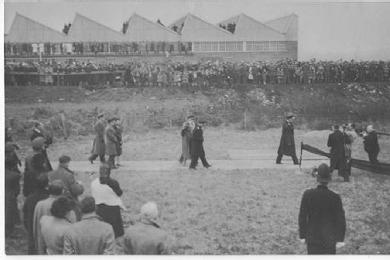
The design department and management was in Northampton, but the main factory was in Swansea.
The company moved its headquarters to Swansea in 1952, although design and development remained in 14 Harleston Road, St James End Northampton.
1952: The factory was enlarged and now totalled 200,000 sq. ft. of working space, where they now housed the production and commercial sections. After this came the installation of the high-capacity injection-moulding machinery.
1952: Swansea now became the official company headquarters.
1956: Corgi Toys were introduced in the UK in July 1956 and were manufactured in a newly built factory at Swansea, Wales. A production plant was built at Fforestfach in Swansea to manufacture the new range of Corgi Toys providing many new jobs in an area of high unemployment following the scaling down of local coal mining operations.
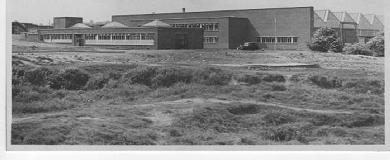
The launch date for the Corgi range was to be the 9th July 1956. The firm of Playcraft Limited (a sister corporation to Mettoy before they both merged) launched the Corgi name to the World. The name coming from a Welsh breed of dog, as both the Mettoy and Playcraft factories were based in Swansea.
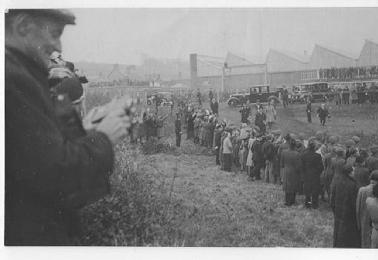
1961: In December there over 1,000 plus employees at its Queensway, Fforestfach factory and they became one of the largest toy manufactures in Britain, with a factory space of over 240,000 sq. feet.
1968: The Mettoy’s factories and warehouses were approximately 385,000 Sq. ft. and a workforce of 3,500 people.
1969: 10th March disaster struck with fire at the Queensway warehouse, many thought the company wouldn't survive. There was indeed a fire at the Corgi factory in 1969, march 10th to be exact, which destroyed the warehouse with over a years stock.
1973: An additional space of 48,000 sq. ft. is acquired at Skewen for assembly and storage.
1974: A new die-casting foundry was built in Fforestfach and later a new 50,000 sq. ft. warehouse was opened.
1981: In September Mettoy became a public limited company, but recorded record losses and closed warehouses in Northampton and Skewen.
1984: March of this year there was a management buy-out of The Corgi Toy Company, including the Swansea factory.
1986: A small collection of Corgi die-cast toys were donated to Swansea Museum.
1989:
Mattel purchases the Swansea factory in this year.
1991: The Swansea factory and offices close when Mattel moves to its headquarters
in Leicester. In
January, 1991 the Swansea factory and offices were closed and Corgi moved
to Mattel's UK headquarters in Leicester.
All Corgi 267 Batmobiles were made at the Mettoy plant Swansea South Wales UK.
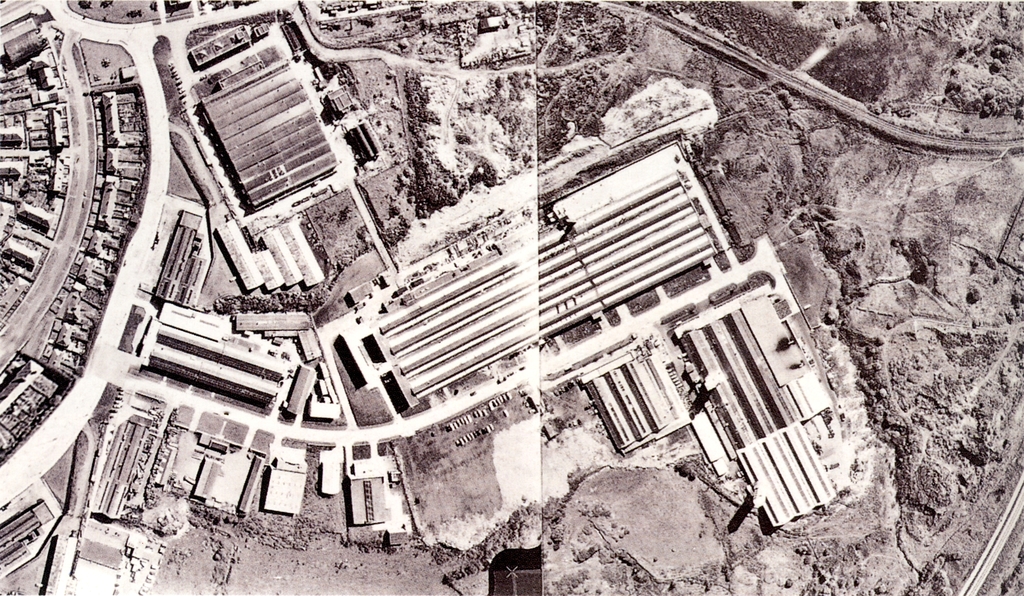 |
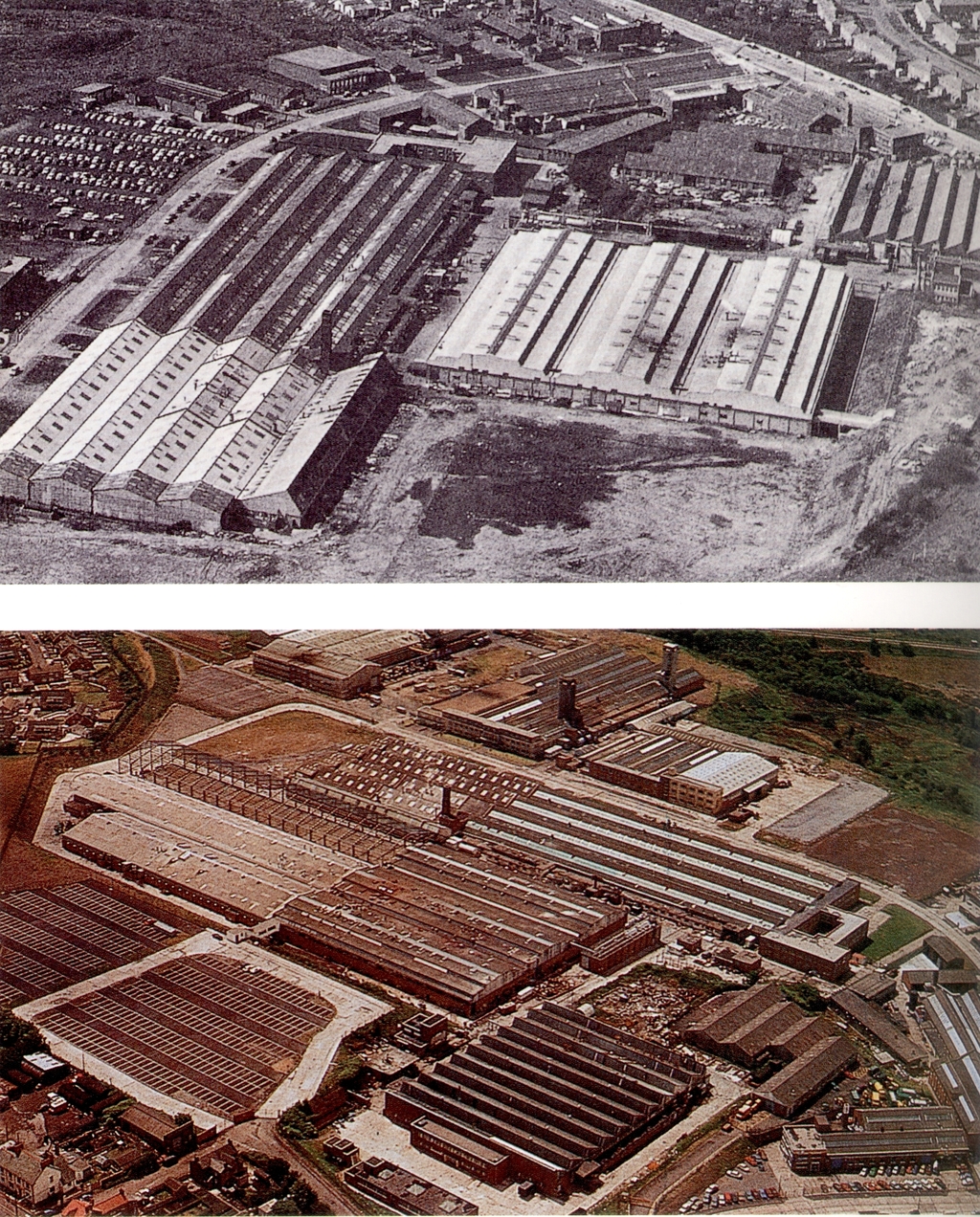 |

 |